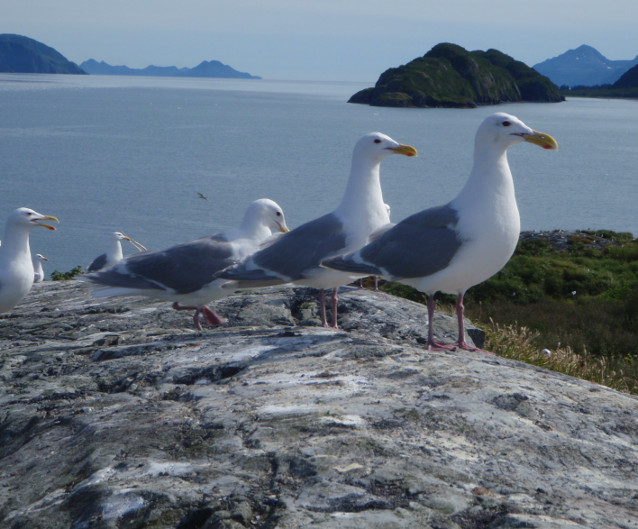Why Monitor Seabird Colonies?

In 1976, U.S. Fish and Wildlife Service biologist E.P. Bailey surveyed the southern coastline of the Kenai Peninsula. He documented large concentrations of breeding seabirds, which verified the abundance of wildlife along the Kenai Fjords coastline and supported the establishment of Kenai Fjords National Park. In 1980, the park was formed under the Alaska National Interest Land Conservation Act, which states that in addition to preserving the environmental integrity of the Harding Icefield, the park would be managed to protect “marine and other birds” and their breeding areas. Fulfilling this mission requires understanding the health and status of seabird populations in the Kenai Fjords area.
Seabirds are also considered an important indicator species for detecting marine ecosystem changes. Many marine organisms are elusive, short-lived, and difficult to monitor. Seabirds, on the other hand, are long-lived, conspicuous, and feed near the top of marine food webs. These characteristics, coupled with their tendency to nest in large colonies, allow seabirds to be counted and monitored relatively easily. By studying seabirds, biologists can detect variances in the abundance and diversity of their prey, the presence of pollutants, and climate change.


Seabird Monitoring

In 1986, U.S. Fish and Wildlife Service and National Park Service conducted a joint resurvey of marine birds along the Kenai Fjords coastline (Nishimoto and Rice 1987). The study was designed to detect large scale changes in seabird populations in the ten years since Bailey’s 1976 survey.
These two seabird surveys provided the only baseline data available to evaluate potential spill impacts on seabird populations in Kenai Fjords when the Exxon Valdez oil spill occurred in March 1989. Additionally, the 1976 and 1986 survey data proved essential for developing post-oil spill recovery goals for breeding seabird populations. Common murres were the most affected by the spill, representing 75% of over 30,000 dead birds retrieved from the Gulf of Alaska following the spill.
Survey efforts in the 1990s primarily focused on murres. Surveys showed that after failing to breed in 1989, breeding murre numbers in the Chiswell Islands (a group of islands adjacent to Kenai Fjords) declined before stabilizing in 1998. Black-legged kittiwakes were also resurveyed in the Chiswell Islands following the oil spill. Unlike murres, Kittiwakes successfully breding in 1989 and the number of breeding kittiwakes did not differ significantly from pre-spill counts. Surveys of other species including cormorants and puffins were inadequate to detect changes in breeding populations following the oil spill.
In 2007, Kenai Fjords National Park, in partnership with the Alaska Maritime National Wildlife Refuge, began breeding seabirds surveys within the park and refuge. Surveys have been conducted annually since 2007 that focus on black-legged kittiwakes; glaucous-winged gulls; common murres; horned and tufted puffins; and red-faced, pelagic and double-crested cormorants.
Park biologists are currently refining survey protocols to maximize efficiency and funding. In contrast to previous years, park biologists in 2011 and 2012 counted the number of birds present on each colony on multiple days to compensate for the varying daily number of adult birds present on a colony. Park biologists visited colonies on as many as ten different days to determine the average number of birds present. These repeated counts will help determine the minimum number of times a colony needs to be counted to obtain an accurate estimate of the number of breeding birds. Colonies are also divided into sections so that in the future, if it is not feasible to count entire colonies these smaller plots could be used to determine trends in colony size.
Seabird Monitoring Results

The number of birds attending a colony can vary within a day and throughout the breeding season. Prior to 2011, breeding seabird colonies were counted only once annually. While this single count could be an accurate number of seabirds in the colony, it could also be influenced by time of day or when the survey occurred during the breeding season. Because of this variability, counting a seabird colony once annually is unreliable for detecting fine scale (subtle) population trends. Park biologists therefore must be cautious drawing conclusions about breeding seabird population trends on the Kenai Fjords coastline. The glaucous-winged gull breeding population appears to have increased between the 1976 and 2007 surveys and then stabilized from 2007 to 2011. Kittiwake and cormorant populations appear relatively stable but horned puffin numbers appear to have declined since 1976. Current intensive studies will develop protocols that identify the fine scale seabird population trends in the future.

References
Bailey, E.P. 1976. Breeding seabird distribution and abundance along the south side of the Kenai Penninsula, Alaska. Unpublished report, U.S. Fish and Wildlife Service, Homer, AK.
Bailey, E.P., and B. Rice. 1989. Assesment of injury to seabird and marine mammal populations along the southeast coast of the Kenai Peninsula, Alaska, from the Exxon Valdez oil spill during summer of 1989. Unpublished report, U.S. Fish and Wildlife Service, Homer, AK.
Dragoo, D.E. 1994. Counts of black-legged kittiwakes at the Chiswell and Barren Islands, Alaska, in 1992. U.S. Fish and Wildlife Service Report, Alaska Maritime National Wildlife Refuge 94/04. Homer, AK.
Nishimoto, M. and B. Rice. 1987. A re-survey of seabirds and marine mammals along the south coast of the Kenai Peninsula, Alaska, during the summer of 1986. Unpublished report, U. S. Fish and Wildlife Service, Homer, AK.
Parsons, M., L. Phillips, J. Curl, and L. Adams. 2011. Seabird colony survey report: Kenai Fjords National Park and Alaska Maritime National Wildlife Refuge. Natural Resource Data Series, National Park Service, Fort Collins, CO.
Roseneau, D.G. and G.V. Byrd. 2002. Common murre population monitoring at the Chiswell Islands, Alaska, 2001. Exxon Valdez Oil Spill Restoration Project Final Report/Restoration Project 01144, U.S. Fish and Wildlife Service, Alaska Maritime National Wildlife Refuge, Homer, AK.
Program Contact:
Park Ecologist
Kenai Fjords National Park
(907) 422-0500
P.O. Box 1727 Seward, AK 99664
Last updated: December 15, 2016
